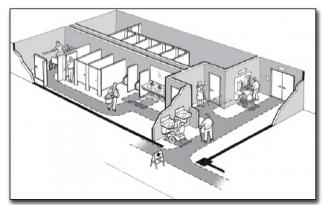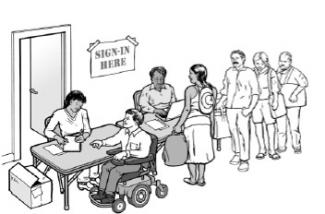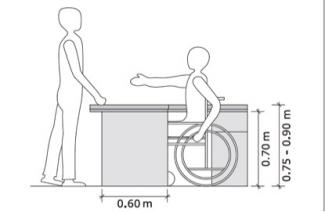Collective centers

Collective centres are pre-existing communal buildings, such as schools, hotels, religious centres, hospitals, or even old factories or military barracks that host populations displaced by conflict or natural disaster.
Whatever the type of collective centres there are common obstacles to those in shelters or other settlements that people with disabilities will face. Consequently both physical and management barriers need to be addressed to ensure safety, dignity and accessibility of persons with disabilities seeking shelter in collective centres:
- Barrier-free entrance, which means wide enough door, no stairs or a ramp, clear contrast colours and indications;
- Accessible registration desk, meaning lower it to the height of a wheelchair, around 80 cm;
- Indoor mobility - address physical barriers to circulation by adding ramps or removing thresholds, leveling surfaces and making sure doors and openings are wide enough for a wheelchair user;
- Provide for possibility for partition of space. Keep stock of for example plywood or curtains which can be used to improve privacy for persons with disabilities, especially women with disabilities who are unable to access other parts of the shelter for their intimate needs;
- Make sure that all areas, especially corridors and public areas are illuminated to faciltate orientation of persons with low vision. It is also important for protection and safety of women and girls;
- Ensure proper signage which indicates path and facilities that are accessible;
- Accessible latrines, washrooms and cooking facilities, and provision of useful and adapted utensils.



Buildings that are used for collective centres have almost always been constructed prior to displacement and thus not designed to be used for accommodation. In countries prone to natural disasters, many governments have existing contingency plans in place, often including pre-designated collective centres or evacuation centres. Most of the time, this creates additional challenges in terms of accessibility and safety of persons with disabilities. While collective centres should always be considered as a last resort when securing housing for displaced populations, they might be an option for temporary placement if well managed. In disaster prone countries, persons with disabilities, including women groups, must be involved at preparation phase, notably to provide guidance on accessibility, safety and protection.